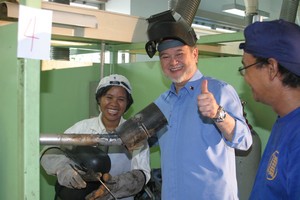Hanjin Subic Shipyard, Drydock No. 5, January 18, 2008 11am : Explosion was heard at the Propeller Alley (This is a compartment at the AFT, STERN, or TAIL portion of the ship)
Fatalities:
Jeremias Adamos – Barretto, Olongapo ( Family from Subic)
Mario Laxamana – Morong, Bataan
Injured:
Jonathan Martinez – Banicain, Olongapo
Gilbert Ruba – Kalalake, Olongapo (from Tarlac)
Donald Elijan – Castillejos, Zambales (All 3 confined at St. Jude Hospital)
1 Korean National and another Filipino w/ minor hand injury.
Many Filipino co-workers were traumatized by the incident.
According to the survivors:
They are working at the rudder and propeller section of the ship: fitting-cutting-welding-grinding inside a closed compartment.
Adamos and Laxamana are working (grinding) overhead, 10 to 12 feet above them.
Martinez and Ruba noticed that there are oil spills on the deck which came from the cleaning operation on the propeller.
The survivors believe that sparks from cutting and grinding operation which fell on the oil started the fire.
Other witness accounts however claimed that the sparks actually fell on the acetylene gas rubber hose.
The punctures on the hose created by hot molten metals caused the flammable gas to leak.
This gas leak, built-up in the propeller-alley compartment during their 10am breaktime.
When they returned for work at 11am, the compartment is already saturated by a highly combustible gas. An accident waiting to happen.
A spark from either welding, grinding or cutting operation ignited the combustible gas which caused the explosion and the fire.
Comments/Recommendations:
• There was no Safety Officer and/or “Fire Watch” in the vicinity while the work was going on.
• The Safety Officer should have conducted “Gas-Free Inspection” prior to start of work.
• Shipyard workers should be alert all the time, keeping their area clean and clear of hazards. The fatalities were not able to escape the fire because their bodies were entangled in the electrical wires (temporary lighting & extension cords) which were not properly organized inside the compartment.
FINAL ANALYSIS:
Since the survivors insisted that the flame actually started from the oily surface of the deck and that they have not smelled traces of combustible gas in the compartment (which would have alerted them when they returned to work after breaktime), this means that oxygen was the gas that leaked.
An oxygen-rich environment would make an ordinary oil highly-flammable.
Possible Causes of this situation are:
1. Defective Oxygen Valve.
2. Somebody deliberately opened the oxygen valve in order to introduce fresh air into the closed compartment or to flush-out smoke from welding operation (A big mistake by untrained personnel).
3. The oxygen rubber hose was accidentally punctured either by hot molten metal from welding sparks or had been mechanically damaged when hit by a sharp/heavy metal/plate.
RE-TRAINING IN SHIPYARD SAFETY IS OBVIOUSLY IN ORDER.
The writer, Olongapo Skills Training Director, Edwin Piano, have more than 20 years of shipyard experience both locally and overseas. He conducts Safety Training for welders endorsed by Mayor James "Bong" Gordon, Jr to Hanjin shipbuilding project.
Labels: hanjin, olongapo, subic, welder


 "Bagumbayan is not a place or a name. It is character, attitude, values and principle. It is a solution to the ills of society
and a vision of a great
country."
"Bagumbayan is not a place or a name. It is character, attitude, values and principle. It is a solution to the ills of society
and a vision of a great
country."











